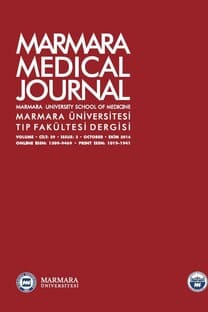The failure on the effectiveness of formalin on cadaver disinfection and alternative methods
Skermanella aerolata, Cadaver, Anatomy, Formalin.
The failure on the effectiveness of formalin on cadaver disinfection and alternative methods
Skermanella aerolata, Cadaver, Anatomy, Formalin.,
___
- Loukas M, Hanna M, Alsaiegh N, Shoja M M, Tubbs R S. Clinical anatomy as practiced by ancient Egyptians. Clin Anat 2011; 24: 409-15. doi: 10.1002/ca.21155
- Gupta J, Chaturvedi M, Patil M. Embalmed cadavers – are they safe to handle, a study to see the microbial flora present in the embalmed cadavers. Int J Pharma Bio Sci 2013; 4:383-6.
- Brenner E. Human body preservation – old and new techniques. J Anat 2014; 224:316-44. doi: 10.1111/joa.12160.
- Kalanjati VP, Prasetiowati L, Alimsardjono H. The use of lower formalin-containing embalming solution for anatomy cadaver preparation. Med J Indones 2012; 21:203-7.
- Ruhsar E, Demiraslan Y. Kadavra hazırlamada kullanılan solüsyonlar ve güncel yaklaşımlar. Dicle Üniversitesi Veteriner Fakültesi Dergisi 2018; 11:105-8.
- Benkhadra M, Gerard J, Genelot D, et al. Is Thiel’s embalming method widely known? A world survey about its use. Surg Radiol Anat 2011; 33: 359-63. doi: 10.1007/s00276.010.0705-6
- Balta J Y, Cronin M, Cryan J F, O’Mahony S M. Human preservation techniques in anatomy: a 21st century medical education perspective. Clin Anat 2015; 28:725-34. doi: 10.1002/ca.22585
- Demiryurek D, Bayramoglu A, Ustacelebi S. Infective agents in fixed human cadavers: a brief review and suggested guidelines. Anat Rec 2002; 269: 194-7. doi: 10.1002/ar.10143
- Kaufman M. Dangerous dissections: the hazard from bodies supplied to Edinburgh anatomists, winter session, 1848-9. J. R. Coll Physicians Edinb 2005; 35: 268-74.
- Sri-Indrasutdhi V, Ueapattanakit J, Sommatas A. Investigation of airborne fungi and their ability to grow on formalin-fixed human cadavers. Mycosphere 2015; 6:729-36. doi:10.5943/ mycosphere/6/6/8
- Faghani L M, Farzanegan A. Decrease of microbial contamination by application of routinely glycerol and phenol solution on human cadavers. J Curr Biomed Rep 2021; 2:74-8.
- Dworzanski J P, Snyder A P. Classification and identification of bacteria using mass spectrometry-based proteomics. Expert Review of Proteomics 2005; 2:863-78. doi: 10.1586/14789450.2.6.863
- Weisburg W G, Barns S M, Pelletier D A, Lane D J. 16S ribosomal DNA amplification for phylogenetic study. J Bacteriol 1991; 173:697-703. doi: 10.1128/jb.173.2.697.703.1991
- Altschul S F, Gish W, Miller W, Myers E W and Lipman D J. Basic local alignment search tool. J Mol Biol 1990; 215:403-10. doi: 10.1016/S0022-2836(05)80360-2
- Akamatsu T, Minemoto M, Uyeda M. Evaluation of the antimicrobial activity and materials compatibility of orthophthalaldehyde as a high-level disinfectant. J Int Med Res 2005;33:178-87. doi: 10.1177/147.323.000503300205.
- Brenner E, Maurer H, Moriggl B and Pomaroli A. The human cadaver as an educational tool – classification and comparison with other educational tools. Ann Anat 2003; 185: 229-30.
- Skerman V B D, Sly L I, Williamson M L. Conglomeromonas largomobilis gen. nov., sp. nov., a sodium-sensitive, mixedflagellated organism from fresh waters. Int J Syst Bacteriol 1983; 33:300-8.
- Sly L I, Stackebrandt E. Description of Skermanella parooensis gen. nov., sp. nov. to accommodate Conglomeromonas largomobilis subsp. parooensis following the transfer of Conglomeromonas largomobilis subsp. largomobilis to the genus Azospirillum. International Journal of Systematic and Evolutionary Microbiology 1999; 49:541-4.
- Weon H Y, Kim B Y, Hong S B, et al. Skermanella aerolata sp. nov., isolated from air, and emended description of the genus Skermanella. Int J Syst Evol Microbiol 2007 ;57:1539-42. doi: 10.1099/ijs.0.64676-0.
- Onori R, Marín M, Rodríguez-Sánchez B, et al. First isolation of Skermanella aerolata from a human sample. Rev Esp Quimioter 2018; 31:552-3.
- Heo S T, Kwon K T, Yoo J R, Choi J Y, Lee K H, Ko K S. First case of necrotizing fasciitis caused by Skermanella aerolata infection mimicking vibrio sepsis. Ann Lab Med 2018;38:604- 6. doi: 10.3343/alm.2018.38.6.604.
- ISSN: 1019-1941
- Yayın Aralığı: 3
- Başlangıç: 1988
- Yayıncı: Marmara Üniversitesi
Effect of troponin I and coagulation parameters on mortality in COVID-19 patients
Meral DAG, Nilufer BULUT, M. Cagatay TASKAPAN
Burden, depression and fatigue in caregivers of lung transplantation candidates
Sehnaz OLGUN YILDIZELI, Asli TUFAN CINCIN, Huseyin ARIKAN, Emel ERYUKSEL
Healthy life-style behaviors and related factors among Turkish primary health care professionals
Belgin ORAL, Nergiz SEVINC, Burcu KORKUT
Being a mother as a healthcare professional in the COVID-19 pandemic: A qualitative study
Nesibe GUNAY MOLU, Sadiye SERT, Neslihan DURMUSOGLU SALTALI
Reliability of antibody tests for COVID-19 diagnosis
Nilay COPLU, Cetin KILINC, Aysegul GOZALAN, Busra CALISIR, Cemile SONMEZ, Mustafa Muhammet GUL, Zeynep AYGUN AHLATCIOGLU
Ayse UYSAL, Mehmet Ali ERKURT, Irfan KURU, Emin KAYA, Ilhami BERBER, Ahmet SARICI, Soykan BICIM, Ahmet KAYA, Emine HIDAYET
Molecular analysis of human adenoviral keratoconjunctivitis cases: Results of a 2-year survey
Ayfer GUNER, Rabia CAN SARINOGLU, Fahri Onur AYDIN, Semra AKKAYA TURHAN, Mert Ahmet KUSKUCU, Ayse Ebru TOKER, Aysegul KARAHASAN YAGCI
Kadriye ERDOGAN, Nazlı Tunca SANLIER, Emine UTLU OZEN, Serdar DILBAZ, Inci KAHYAOGLU, Yaprak Engin USTUN
